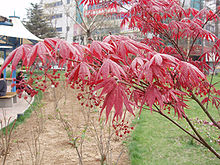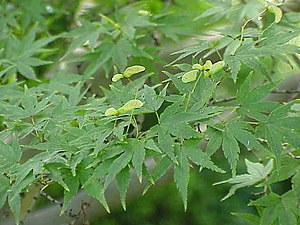Acer palmatum
Acer palmatum (Japanese Maple or Smooth Japanese Maple; is a species of maple native to Japan and South Korea. Some authorities state it is also native to China,[1] but the Flora of China treats similar native Chinese maples as separate species.[2]
Description[edit | edit source]
It is a deciduous shrub or small tree reaching heights of 6–10 m, rarely 16 m, often growing as an understory plant in shady woodlands. It may have multiple trunks joining close to the ground. In habit, it is often shaped like an upside-down pyramid (especially when younger) or takes on a dome-like form, especially when mature.[3] The leaves are 4–12 cm long and wide, palmately lobed with five, seven, or nine acutely pointed lobes. The flowers are produced in small cymes, the individual flowers with five red or purple sepals and five whitish petals. The fruit is a pair of winged samaras, each samara 2–3 cm long with a 6–8 mm seed. The seeds of Japanese maple and similar species require stratification in order to germinate.[3][4]
Even in nature, Acer palmatum displays considerable genetic variation. As such, even seedlings with the same parent tree can show difference in such aspects as leaf size and shape, and colour.[3]
Growing Conditions[edit | edit source]
Like most maples, it is fairly adaptable but grows best in deep, well-drained, fertile soils. It grows well as an understory tree, tolerating fairly dense shade. However, they also cast deep shadows, making planting other plants under them difficult. Seedlings can become a nuisance, and has the potential to become invasive in woodlands.
Varieties[edit | edit source]
Three subspecies are recognised:[3][4]
- Acer palmatum subsp. palmatum. Leaves small, 4–7 cm wide, with five or seven lobes and double-serrate margins; seed wings 10–15 mm. Lower altitudes throughout central and southern Japan (not Hokkaido).
- Acer palmatum subsp. amoenum (Carrière) H.Hara. Leaves larger, 6–12 cm wide, with seven or nine lobes and single-serrate margins; seed wings 20–25 mm. Higher altitudes throughout Japan and South Korea.
- Acer palmatum subsp. matsumurae Koidz. Leaves larger, 6–12 cm wide, with seven (rarely five or nine) lobes and double-serrate margins; seed wings 15–25 mm. Higher altitudes throughout Japan.
Cultivars[edit | edit source]
Over 1,000 cultivars have been chosen for particular characteristics, and can only be propagated by grafting. Some of these are not in cultivation in the Western world or have been lost over the generations, but many new cultivars are developed each decade.[3] These cultivars are chosen for such phenotypical aspects as leaf shape and size (shallowly to deeply lobed, some also palmately compound), leaf colour (ranging from chartreuse through dark green or from red to dark purple, others variegated with various patterns of white and pink), bark texture and colour, and growth pattern. Some cultivars are sturdy trees that are larger and more hardy or vigorous than the species. Many are shrubs rarely reaching over 0.5 m in height. A few very delicate cultivars are typically grown in pots and rarely reaching heights of more than 30 cm. Some of the more distorted or dwarfed cultivars are grown from witch's brooms, but more are based upon clippings taken from plants that are mutated and/or have been artificially selected over many generations.[3]
Many cultivars have characteristics that come into prominence during different seasons, including the colour of new or mature leaves, extraordinary fall colour, colour and shape of samaras, or even bark that becomes more brightly coloured during the winter. Some cultivars can scarcely be distinguished from others unless labeled. In some cases, identical cultivars go by different names, while in other cases, different cultivars may be given the same name.
Example cultivars[edit | edit source]


A selection of notable or popular cultivars, with brief notes about characteristics that apply during at least one season, includes the following.[3]
- 'Aka shigitatsu sawa', pinkish-white leaves with green veins
- 'Ao ba jo' - a dwarf with bronze-green summer foliage
- 'Atropurpureum' - wine-red, including new branches
- 'Bloodgood' - an improved cultivar of 'Atropurpureum'
- 'Butterfly' - small leaves with white borders
- 'Dissectum' - lace-like leaves, drooping habit
- 'Golden Pond' - greenish-yellow summer foliage
- 'Goshiki koto hime' - a delicate, variegated dwarf
- 'Higasa yama' - crinkled leaves variegated with yellow
- 'Hupp's Dwarf' - a small, dense shrub with miniature leaves
- 'Issai nishiki kawazu' - very rough, rigid bark
- 'Kagiri nishiki' - similar to 'Butterfly' but more pinkish tones
- 'Karasu gawa' - slow-growing variegate with brilliant pink and white
- 'Katsura' -yellow-green leaves tipped with orange
- 'Koto no ito' - light green, thread-like leaves
- 'Little Princess' - a sparsely-branched dwarf with irregular habit
- 'Mama'- a bushy dwarf with extremely variable foliage
- 'Masu murasaki' - a shrubby tree with purple leaves
- 'Mizu kuguri' - orange-tinted new growth and very wide habit
- 'Nishiki gawa' - pinetree-like park desirable for bonsai
- 'Nomura nishiki' - dark purple, lace-like leaves
- 'Ojishi' - tiny dwarf, grows only a few centimetres per year
- 'Osakazuki' - tree-like shrub with spectacular autumn colour
- 'Peaches and Cream' - similar to 'Aka shigitatsu sawa'
- 'Pink Filigree' - finely dissected, brownish-pink leaves
- 'Red Filigree Lace' - delicate, finely dissected, dark purple
- 'Sango kaku' - "coralbark maple" with pinkish-red bark
- 'Seiryu' - a green, tree-like shrub with finely dissected leaves
- 'Shikage ori nishiki'- vase-shaped shrub with dull purple foliage
- 'Skeeter's Broom' - derived from a 'Bloodgood' witch's broom
- 'Tamukeyama' - finely dissected, dark purple, cascading habit
- 'Tropenburg' - slender, upright grower, convex lobes, purple leaves
- 'Tsuma gaki' - yellow leaves with reddish-purple borders
- 'Uki gumo' - prominent white-speckled variegation
- 'Waka momiji' - another "coralbark" maple
- 'Yuba e' - upright tree with scarlet variegation

In addition to the cultivars described above, a number of Cultivar Groups have been naturally selected over time to such an extent that seedlings often resemble the parent. Many of these are sold under the same name as the cultivars, or even propagated by grafting, so there is often much ambiguity in distinguishing them.[3] In particular, a number of dark-red Japanese maples are sold with the names "Atropurpureum" and "Bloodgood". Many maples with delicate lace-like foliage are sold under names such as "Dissectum", "Filigree" and "Laceleaf".[3]
Similar species[edit | edit source]
The term "Japanese Maple" is also sometimes used to describe other species within series Palmata that are similar to A. palmatum and are native to China, Korea or Japan including:
- Acer duplicatoserratum (syn. A. palmatum var. pubescens Li)
- Acer japonicum - Downy Japanese Maple
- Acer pseudosieboldianum - Korean Maple
- Acer shirasawanum - Fullmoon Maple
- Acer sieboldianum - Siebold's Maple
Given that these maples are phenotypically variable within each species, and may hybridise with one another, distinguishing between them may be a matter of gradient speciation. In commercial propagation, A. palmatum is often used as rootstock for these other species.[3]
Uses[edit | edit source]

Japanese Maple has been grown in temperate areas around the world since the 19th century and has been cultivated in Japan for centuries.[3] In Japan it is used as an accent tree in Japanese gardens, providing gentle shade next to the house in the summer and beautiful colors in fall. Numerous cultivars are readily available commercially and are a popular item at garden centres and other retail stores in Europe and North America. Red-leafed cultivars are the most popular, followed by cascading green shrubs with deeply dissected leaves.[3] It is also a popular and appropriate choice for bonsai enthusiasts and has been used in this art throughout its history.
Maintenance[edit | edit source]
Like all maples, A. palmatum tolerates heavy pruning, but should not be pruned in winter due to severe bleeding that can occur during early spring.
Propagation[edit | edit source]
Pests and Diseases[edit | edit source]
See Acer for a list of pests and diseases.
References[edit | edit source]
| Wikiversity is collecting bloom time data for Acer palmatum on the Bloom Clock |
- ↑ Germplasm Resources Information Network: Acer palmatum
- ↑ Flora of China (draft): Acer
- ↑ a b c d e f g h i j k l van Gelderen, C.J. & van Gelderen, D.M. (1999). Maples for Gardens: A Color Encyclopedia.
- ↑ a b Rushforth, K. (1999). Trees of Britain and Europe. Collins ISBN 0-00-220013-9.
